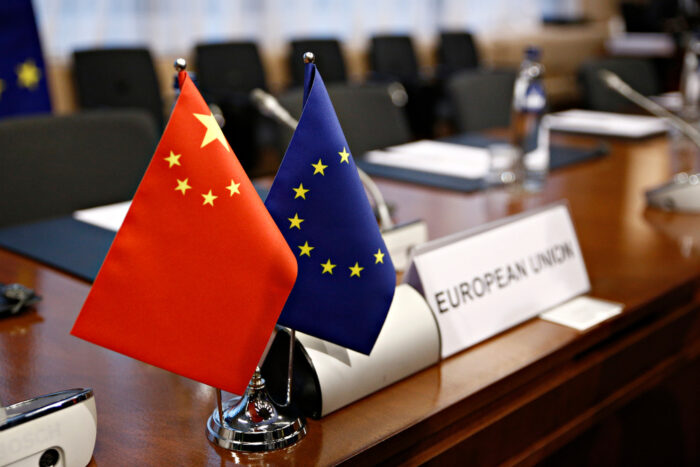Find all related Progressive Post
Progressive Post

An anxious and abandoned electorate delivered a landslide victory to Donald Trump. In the most polarised election in modern history, decisive numbers of Democrats stayed home. Decades into trying to be the party of both Wall Street and working families, Democrats will have to fight their way back to relevance by making a choice between them.
Looking at an election map, you’ll see thousands of arrows pointing to the right. Each signifies how much closer voters moved to Trump in the last four years. His victory was total. Trump made sweeping gains in red states, in battleground and blue states. He owned the electorate.
It feels like an eclipse of the sun. The political class will say this was a change election and Democrats were unlucky to be the incumbents. This answer shirks responsibility. This was not just voting for change. You do not vote for Donald Trump because you want something a bit different. This was a revolt against the neoliberal politics that are failing everyday people. Americans are experiencing a loss of security and a loss of hope that cuts across generations.
I think people came to this election asking: whose side are you on? And in failing to find anyone on theirs, they chose someone willing to fight the system itself. Others turned away from the system themselves, with decisive numbers of Democrats choosing not to vote in the most polarised election of our lifetime.
Amongst Trump’s supporters, there is certainly an overrepresentation of angry men. But not only. There are a whole lot of fired-up white people in there – men and women – voting very explicitly for white power. But not only. It is a broader dislocation than that. A crisis of meaning and purpose. One built of the impotence we feel in facing a future we can neither imagine nor control. Where what’s left is a fight between the last and the second last. Trump is taking deep economic and social insecurity, stoking fear, and turning it into ‘The Hunger Games’.
The alternative to weaponised division cannot be only a set of policy reforms designed to mitigate the worst of the market’s failures. On a number of measures, the Biden administration did well on that front, better than other post-war administrations. Wages are higher. There are more jobs. There are better jobs. That is thanks to both the broader power given to unions and the sheer amount of funding for new public jobs. There was a moment when Covid-19 made Social Democrats of us all. We ensured eviction protection, created massive public works programmes, and attempted to raise living standards across the board. That moment passed. But we need to recognise that we are still a world in crisis.
For those who are getting by, it feels tenuous. For those who are not, it feels hopeless. We have returned to treating jobs like they are the trickle-down benefit of profitable business. We need instead to centre work and the workers who are the engine of that profit. And we haven’t even begun to address the question of meaningful work if corporations still get to decide what economy we are living in.
In politics, we often ask how we demonstrate to voters that we are better on the economy? But what if we asked instead: what would it take to deliver a fair economy? It would take a plan. A plan that protects work and workers through the accelerating changes in the labour landscape, and the inequalities they generate. A plan that was not dependent on whether companies had a good quarter. A plan that reorganised the economy to substantively and steadily improve the overall quality of life of everyone – rather than the 12 per cent annual growth that only Wall Street has been enjoying.
It would have to be a plan with comprehensive social welfare – one that can support the soon-to-be half of the US workforce that does not have a traditional employer. This includes gig workers, whose labour companies like Uber exploit while failing to provide even the modest protections a job must offer. A plan that includes freelancers and people with ‘sometimes work’ – a plan built to support civil rights and all those who do not and cannot work.
What stands between this moment and that plan is not an absence of resources, it is a fundamentally American ideology that holds that we should not interfere with ‘the economy’. That embraces an American dream whose keystone is the personal accumulation of wealth. We trust market forces to keep families healthy, fed, rested and secure. It is not working. It cannot work. Markets and capital need our consumption, they need our labour. Our well-being is immaterial. What has been set in motion and where it will land is hard to fathom. We did not rise to the moment that could have prevented this, but we can rise to the one to come.
It will require a fight and a realignment – a different American dream. You cannot be the party that serves wealth, profit and people. We came close enough to winning majorities for long enough that we forgot – or were too conflicted – to choose. But it is no longer just about winning an election. It is about building a society – a society that has the security to hope, a society not at war with each other, a society whose trust we will have to earn.
There is something very concrete that the European Socialist family can do at this moment: be Socialists. Show us that there has been and can be an alternative. Highlight and strengthen the role of government in serving the people who create it. Recommit to or build anew the Social Democratic systems that put security and well-being at their centre. The American century has come to an ignominious end. What follows can be a better era, a multipolar world built on the foundations of Social Democracy. Or something more like barbarism.
Photo credits: Shutterstock.com/Robin Guess
| Cookie | Duration | Description |
|---|---|---|
| cookielawinfo-checkbox-advertisement | 1 year | Set by the GDPR Cookie Consent plugin, this cookie is used to record the user consent for the cookies in the "Advertisement" category . |
| cookielawinfo-checkbox-analytics | 11 months | This cookie is set by GDPR Cookie Consent plugin. The cookie is used to store the user consent for the cookies in the category "Analytics". |
| cookielawinfo-checkbox-functional | 11 months | The cookie is set by GDPR cookie consent to record the user consent for the cookies in the category "Functional". |
| cookielawinfo-checkbox-necessary | 11 months | This cookie is set by GDPR Cookie Consent plugin. The cookies is used to store the user consent for the cookies in the category "Necessary". |
| cookielawinfo-checkbox-others | 11 months | This cookie is set by GDPR Cookie Consent plugin. The cookie is used to store the user consent for the cookies in the category "Other. |
| cookielawinfo-checkbox-performance | 11 months | This cookie is set by GDPR Cookie Consent plugin. The cookie is used to store the user consent for the cookies in the category "Performance". |
| csrftoken | past | This cookie is associated with Django web development platform for python. Used to help protect the website against Cross-Site Request Forgery attacks |
| JSESSIONID | session | The JSESSIONID cookie is used by New Relic to store a session identifier so that New Relic can monitor session counts for an application. |
| viewed_cookie_policy | 11 months | The cookie is set by the GDPR Cookie Consent plugin and is used to store whether or not user has consented to the use of cookies. It does not store any personal data. |
| Cookie | Duration | Description |
|---|---|---|
| __cf_bm | 30 minutes | This cookie, set by Cloudflare, is used to support Cloudflare Bot Management. |
| S | 1 hour | Used by Yahoo to provide ads, content or analytics. |
| sp_landing | 1 day | The sp_landing is set by Spotify to implement audio content from Spotify on the website and also registers information on user interaction related to the audio content. |
| sp_t | 1 year | The sp_t cookie is set by Spotify to implement audio content from Spotify on the website and also registers information on user interaction related to the audio content. |
| Cookie | Duration | Description |
|---|---|---|
| CONSENT | 2 years | YouTube sets this cookie via embedded youtube-videos and registers anonymous statistical data. |
| iutk | session | This cookie is used by Issuu analytic system to gather information regarding visitor activity on Issuu products. |
| s_vi | 2 years | An Adobe Analytics cookie that uses a unique visitor ID time/date stamp to identify a unique vistor to the website. |
| Cookie | Duration | Description |
|---|---|---|
| NID | 6 months | NID cookie, set by Google, is used for advertising purposes; to limit the number of times the user sees an ad, to mute unwanted ads, and to measure the effectiveness of ads. |
| VISITOR_INFO1_LIVE | 5 months 27 days | A cookie set by YouTube to measure bandwidth that determines whether the user gets the new or old player interface. |
| YSC | session | YSC cookie is set by Youtube and is used to track the views of embedded videos on Youtube pages. |
| yt-remote-connected-devices | never | YouTube sets this cookie to store the video preferences of the user using embedded YouTube video. |
| yt-remote-device-id | never | YouTube sets this cookie to store the video preferences of the user using embedded YouTube video. |
| yt.innertube::nextId | never | This cookie, set by YouTube, registers a unique ID to store data on what videos from YouTube the user has seen. |
| yt.innertube::requests | never | This cookie, set by YouTube, registers a unique ID to store data on what videos from YouTube the user has seen. |
| Cookie | Duration | Description |
|---|---|---|
| COMPASS | 1 hour | No description |
| ed3e2e5e5460c5b72cba896c22a5ff98 | session | No description available. |
| loglevel | never | No description available. |


